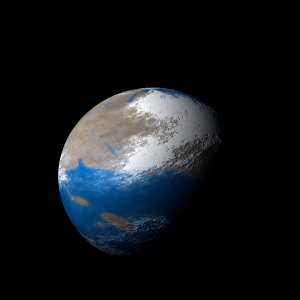|
|
Space Astro
|
Info for exoplanet "Pasiste Stetea"
| Scientific (actual) data |
|---|
| Planet | Kepler-677 b |
| Planet status | Confirmed |
| Radius | 0.48 |
| Orbital period | 6.57532 |
| Discovered | 2016 |
| Updated | 2021-02-05 |
| Tconj | 2455010 |
| Publication | Announced on a website |
| Detection type | Primary Transit |
| Alternate names | 2MASS J19202353+5019177 b, K00782.01, KIC 11960862 b, KOI-782 b, KOI-782.01 |
| Star name | Kepler-677 |
| Right ascension | 290.1° |
| Declination | 50.32° |
| Mag j | 14.071 |
| Mag h | 13.793 |
| Mag k | 13.686 |
| Star distance | 1180 |
| Star metallicity | 0.06 |
| Star mass | 1 |
| Star radius | 0.99 |
| Star age | 4.57 |
| Star temperature | 5723 |
| Star alternate names | 2MASS J19202353+5019177, KIC 11960862, KOI-782 |
| Wikipedia article | Kepler-677 b |
Back
| |
| Fictional info (?) |
|---|
| Suggested name | Pasiste Stetea |
| Planet type | Cold planet |
| Pasiste Stetea is a terrestrial planet with a thin atmosphere, having surface features reminiscent both of the impact craters of the Moon and the valleys, deserts, and polar ice caps of Earth. Pasiste Stetea is orbiting Kepler-677 every 6.6 Earth days.
The planet is named after the deity Pasiste Stetea, the bringer of fear.
Pasiste Stetea's axis has the smallest tilt of any of its solar system's planets.
Pasiste Stetea is by far the hottest planet in its solar system, with a mean surface temperature of 522°K (249°C), even though Kakin-pe is closer to Kepler-677.
Future astrobiology missions are planned, including the Pasiste Stetea 1300 and ExoPasiste Stetea rovers. The volume of water detected has been estimated to be equivalent to the volume of water in Earth's oceans.
Pasiste Stetea is primarily composed of hydrogen chloride with a significant part of its mass being hydrogen peroxide, though hydrogen peroxide comprises only about a small fraction of the number of molecules.
In 2085, images from Wayfinder 6 showed Pasiste Stetea as an almost featureless planet in visible light, without the cloud bands or storms associated with the other cold planets. |
| Atmosphere | Hydrogen chloride | 91% |
| Hydrogen peroxide | 8.4% |
| Molecular hydrogen | 0.038% |
| Argon | 0.001% |
| Methane | 1.8E-5% |
| Atmospheric pressure | 0.018 bar |
 |
| No known satellites |
| Google search for Pasiste stetea |
|
Website by Joachim Michaelis
|
|
|
|